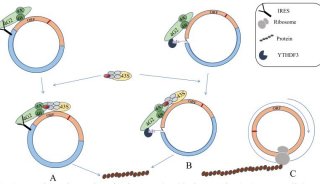Cloning of small RNAs with 5’ phosphate and 3’ OH ends-2
3’ Adaptor Ligation and Purification
Heat shock the RNA by putting at 90°C for 30 seconds. Snap cool on ice.
Set up the 3’Adaptor ligation reaction in a 1.5 ml siliconized tube:
Purified 5’ ligation product from step 2.15 6.4µl
3’ RNA adaptor (10µM) 0.6µl
10X RNA ligation buffer 1µl
T4 RNA ligase (10 U/µl) 1µl
RNAguard (40 U/µl) 1µl
Incubate at 37°C for 1 hour (or overnight at +20°C for 6 hours then 4°C incubation).
Stop reaction by adding 10µl 2x Gel Loading Buffer II OR 10µl 100% formamide plus loading dye. Heat ligated sample/loading buffer mixture at 65°C for 5 minutes prior to loading gel.
Prerun a 0.5X 10% Urea gel for 30 minutes at 200V. Wash the wells with 0.5X TBE.
12.5 ml makes two 0.75mm gels
5.25g Urea
625µl 10X TBE
3.125 ml 40% acrylamide (19:1 acrylamide:bis-acrylamide)
Dissolve urea in 12.5 ml water, then
Add 87.5µl 10% APS
4.4µl TEMED
Pour immediately
Load the ligated samples and 10µl of the 60-80 nt ladder in wells. It is advisable to either run all samples on separate gels or run the ladder with each sample and cut the gel into individual pieces before staining to avoid contamination. Run gel at 150V until the xylene cyanol is above the bottom of the gel (on a 10% gel it runs around 55 nt). Stain the gel or the ladder portion of the gel with 0.5X TBE / EtBr.
Cut out the gel band corresponding to 60-80 nt with a clean razor blade and transfer to a 0.5 ml RNase-free microtube whose bottom has been punctured 3 to 4 times by a 21 gauge needle.
Place this tube into a 2 ml RNase-free round-bottom microtube and spin the gel through the hole into the 2 ml tube at full speed for 2 min.
Add 500µl of sterile 0.3 M NaCl to the tube and elute the RNA by rotating the tube overnight at 4°C.
Transfer the eluate and the gel debris into a Spin-X Cellulose Acetate filter and spin at full speed for 2 minutes.
Wash the gel bits once more with 100µl 0.3M NaCl and spin for another 2 min. Collect the 100µl eluate in the same tube.
Add an equal volume (~600µl) of 100% Isopropanol and 3µl of glycogen to the sample and incubate at –80°C for 20 to 30 minutes.
Spin down at 14K rpm for 30 minutes in a 4°C microcentrifuge.
Carefully remove supernatant and wash pellet with 750µl of room temperature 75% EtOH. Allow the RNA pellet to air dry then dissolve the RNA in total of 4.5µl of DEPC-treated water (we used Ambion’s nuclease-free water).
RT-PCR of small RNAs ligated with adaptors
Set up a reverse transcription reaction in a 1.5 ml RNase-free microfuge tube:
Purified ligated RNA from step 3.15 4.5 µl
Small RNA RT-primer (100 µM) 0.5 µl
Heat to 65°C for 10 minutes, spin down to cool.
Add following in order:
5X First-Strand buffer 2.0 µl
12.5 mM dNTP mix 0.5 µl
100 mM DTT 1 µl
RNAguard(40U/µl) 0.5 µl
Heat to 48°C for 3 min and then add 1.0 µl of SuperScript™ II RT (200U/µl).
Incubate at 42°C for 1 hour.
Set up pilot 20 µl PCR reactions from the Reverse Transcription samples to check and see if the cloning steps worked. I normally clone and manually sequence from this reaction. If everything looks good, then I scale up for the final PCR. Also, the number of PCR cycles can be optimized here. Start with 15 cycles and then go up or down depending on the strength of the product. Another way is to do the large scale PCR, then take an aliquot of the PCR product and clone it into pgemT. The uncloned portion will then be ready for sequencing. Please go to section 6 if you wish to proceed in this way.
NOTE: If ready for the final PCR reaction, skip to section: Scaled-up PCR for final cloning.
RT reaction mix from step 4.5 1µl
5X Phusion™ HF Buffer 4 µl
Small RNA PCR Primer 1 (10uM) 0.25 µl
Small RNA PCR Primer 2 (10uM) 0.25 µl
2.5 mM dNTP mix 2.0 µl
Phusion™ DNA Polymerase 0.2 µl
H2O 12.3 µl
PCR Conditions:
98°C 30 sec
98°C 10 sec |
58°C 30 sec |15 Cycles of PCR
72°C 20 sec |
72°C 5 min
4°C forever
To manually clone the PCR product, add 1µl of Taq to the above PCR reaction after it has finished. Incubate at 72°C for 15 min. This adds A’s to the end and allows for pgem cloning. Phusion polymerase does not add As.
Pour a 1.5 mm 6% TBE native gel in the Biorad MiniProtean II to visualize the PCR products. It is advisable to use 1 ladder per sample or cut the ladder off and stain separately or run individual gels for each sample to avoid contamination.
25 ml makes two 1.5 mm gels or four 0.75mm gels
1.25 ml 10X TBE
3.75 ml 40% acrylamide (19:1 acrylamide:bis-acrylamide)
Water to 25 ml
Add 175 µl 10% APS
8.75 µl TEMED
Pour immediately
After the PCR is finished, (and after the As have been added if you chose to do so), add 4 µl of DNA loading buffer to 20µl of your PCR sample and load into 6% non-denaturing gel. Also, load 0.5µg (5µl) of the Fermentas 100bp ladder along with 4µl of the SIGMA 20bp low ladder dilution. It is not necessary to prerun this gel.
Run the gel until the xylene cyanol is 2/3 of the way down the gel. XC runs at 106nt on this gel.
Stain the gel in 0.5X TBE/EtBr buffer for 5 min.
Visualize the gel using UV. Cut out the 92bp band with a clean razor and put band into a 0.5ml microfuge tube whose bottom has been punctured 3 to 4 times by a 21 gauge needle. NOTE: The adapter-adapter band runs at 70 nt.
Place this tube in a 2ml round-bottom microfuge tube and spin the gel through the holes into the 2ml tube by centrifuging 2 min at top speed.
Add 300µl Elution Buffer (10mM Tris-HCl pH7.9; 10mM MgCl2; 50mM NaCl) to the gel debris and shake a 30°C for 1 hour and then put to rotate at 4°C overnight (we have also done JUST 4°C overnight).
Transfer the eluate and the gel debris into a Spin-X filter. Spin for 2 min at full speed. Add another 100µl of elution buffer to wash the gel debris and spin for another 2 min at full speed.
Precipitate the DNA with 40 µl 3M NaOAc pH 5.2; 1 ml 100% Ethanol, 3µl glycoblue.
Centrifuge at top speed for 25 min. Wash the glycoblue pellet with 1 ml 70% EtOH then let dry and resuspend in 6µl water.
pGEM T-cloning.
Mix the following components:
Pgem T vector 1µl
2X ligation buffer 5µl
Small RNAs from step 4.18 3µl
T4 DNA ligase 1µl
Incubate at room temperature for 1 hour or 4°C overnight.
Transform competent E. coli using method of your choice.
PCR colonies using M13F/M13R primers. I sequence 48 inserts per cloning reaction to get the first idea if the small RNA cloning worked. If results look good, scale up the PCR reaction and repeat (comment 4).
Scaled-up PCR for final cloning.
After determining that your small RNA cloning worked or trying everything right from the beginning, set up a 200 µl PCR reaction from using your reverse transcription samples. The number of PCR cycles should have been empirically determined in step 4 (above).
PCR Conditions:
98°C 30 sec
98°C 10 sec |
58°C 30 sec |15 Cycles of PCR (or whatever you want to use)(comment 5)
72°C 20 sec |
72°C 5 min
4°C forever
RT reaction mix from step 4.5 4 µl
5X Phusion™ HF Buffer 40 µl
Small RNA PCR Primer 1 (10uM) 1 µl
Small RNA PCR Primer 2 (10uM) 1 µl
2.5 mM dNTP mix 20 µl
Phusion™ DNA Polymerase 2.0 µl
H2O 132 µl
Precipitate the PCR product with 1/10 volume 3M NaOAC, 2.5 volumes EtOH, 3µl glycoblue overnight at -20 or 15 min at -80. Resuspend in 20 µl water and then add 10 µl of DNA loading buffer. Your samples are ready to be loaded onto a 6% native gel.
Gel purification if doing high throughput sequencing
Pour a native 6% 1.5mm native gel (6% 0.75mm gels are VERY thin and difficult to handle). Prepare the ladder if necessary. We use 2µl of the Sigma 20bp ladder (4µl of dilution) and 0.5µg (5µl of the dilution) of the 100bp Generuler. The lowest size on the gene ruler ladder is 100bp so it helps to locate which band is 100bp on the SIGMA 20bp ladder.
25 ml makes two 1.5mm gels
1.25 ml 10X TBE
3.75 ml 40% acrylamide (19:1 acrylamide:bis-acrylamide)
Water to 25 ml
Add 175 µl 10% APS
8.8 µl TEMED
Pour immediately
-
科技前沿

-
焦点事件














